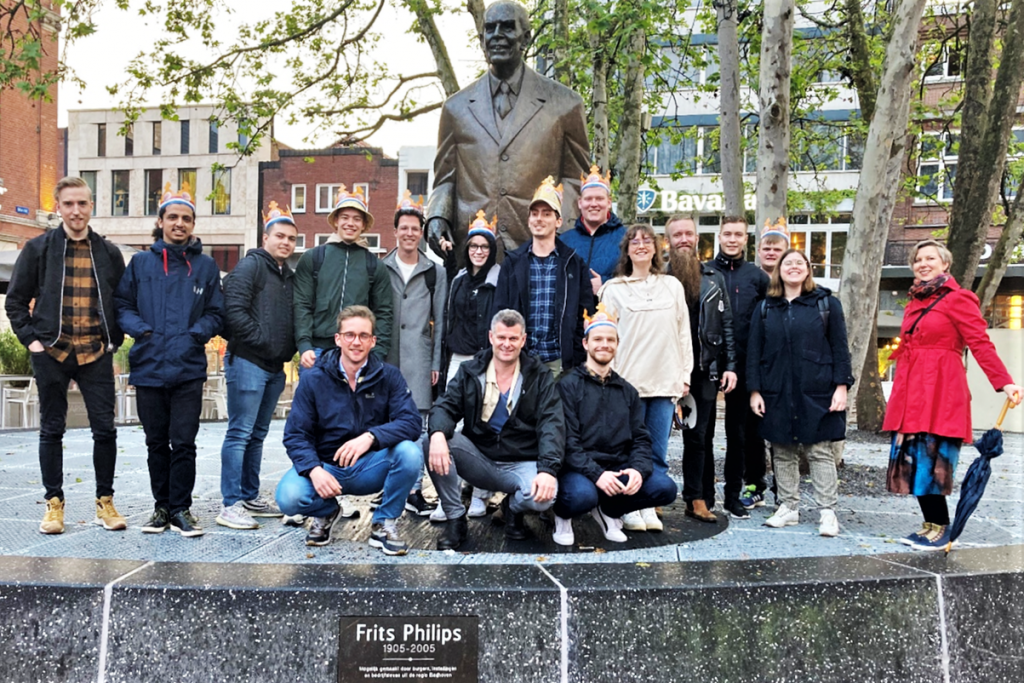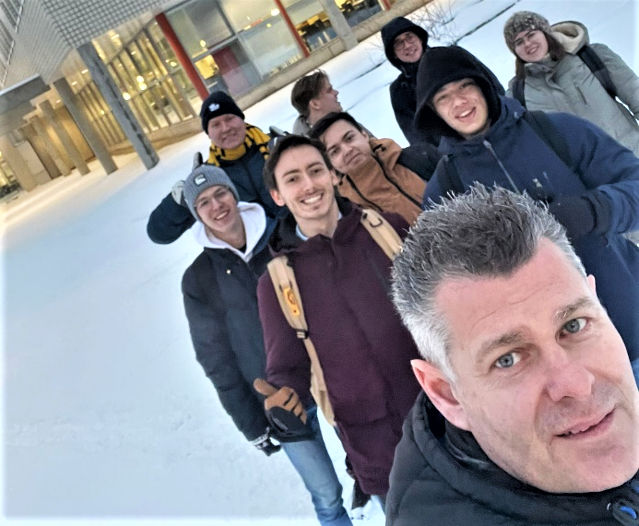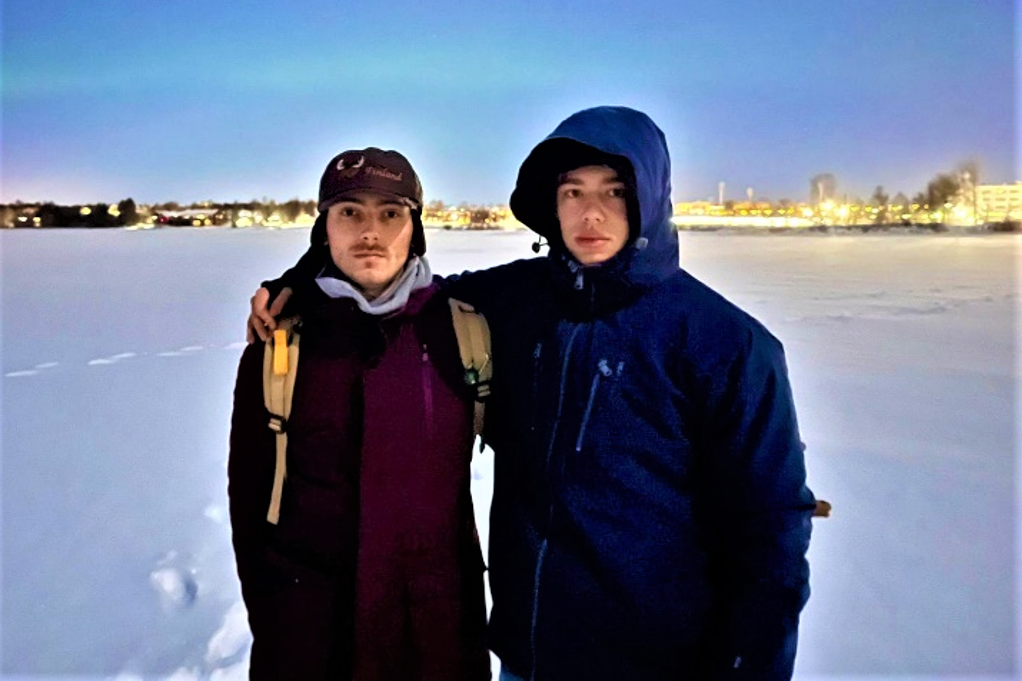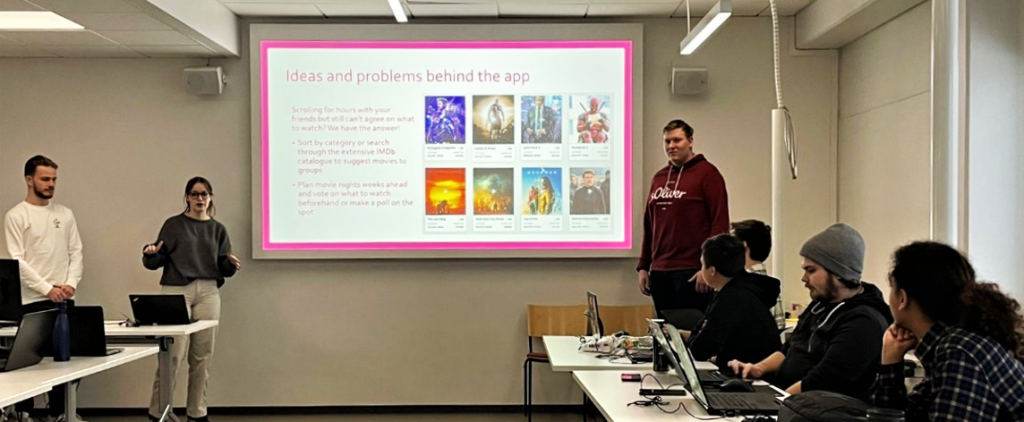Short-term exchanges are a great low-threshold option for an international experience. At best, one learns about different cultures and countries and boosts one’s personal and academic development. It can be thought-provoking, inspiring, and sometimes overwhelming. This blog post is an attempt to share some insights into our experience in the Netherlands – coffee shops and demand-based teaching and all.
I participated in an international Erasmus+ project which consisted of a weeklong visit from Fontys to Oulu, a 13-weeklong virtual part, and a one-week visit from Oulu to Eindhoven. A total of 10 students from Oulu University of Applied Sciences (Oamk), 8 from Fontys University of Applied Sciences, and one teacher from each university participated in the project (picture 1). The idea was to design and implement a mobile or web application in an international project group. This project has been running for years, but this was my first time participating.

International Erasmus projects – all fun and games or sweat and tears?
As soon as we saw a group of youngsters playing in the snow outside the campus, we knew we had found our Dutch visitors (picture 2). The students hit off straight away and during the week, whilst working on the projects, plans were made for after-school activities and for the upcoming trip to the Netherlands, as well. An important part of the project for students is, of course, the cultural experience: getting to know their international peers and exploring another country and culture.

While in Finland, the Dutch students got to experience the Finnish winter with snow and ice (picture 3), the northern lights and a husky safari. Oamk students, on the other hand, got to experience Dutch delicacies daily brought to the campus by the Dutch students, an amusement park, and coffee shops. Finns always being curious about what the foreigners thought about us: The Dutch – being used to bringing their own lunch to school – were very impressed by our school lunch.

The students seemed to get along well and to have fun with each other in and outside the classroom. From the Oamks’ side, there were students from both the Finnish and English degree programs. This was also seen as a bonus by the Oamks’ students:
I really liked the idea of collaborating
with a Dutch university, but also meeting students from another class in Oamk.
The virtual part of the project did not go as smoothly as perhaps the students had hoped for. There were issues with time allocation, communication, and setting up meetings. The workload was divided so that the Fontys students worked on the back-end development and Oamk students on the front-end. The two parts were not collaborating, but rather each working on their own individually. As one of the students put it in the feedback:
I think that the communication between
the two countries was lacking, and it was a shame. At least for our group when the Dutch were here and when we were there, it was really good to be together, and we got a lot done.
Also, the cultural differences were apparent when working on site:
When we’re all working on location,
there was quite a big personality or culture gap in how to work on the project. Although this wasn’t a bad thing.
The exchange week is quite intense: you work on the project all day (pictures 4 and 5) with the group and after work, you go out to explore the sights and the nightlife. You share the accommodation with the other students so you are with them 24/7 and sometimes it can be overwhelming. Even more so for introverted students who require more alone time. For some students, being able to communicate in English can be a tiring struggle. And for some, this can be their first trip abroad, and thus nerve-wracking. Nevertheless, most students appreciate the experience:
The people and the opportunity to
collaborate internationally and build confidence when speaking English.


Things did not always go by the book and not all the planned functionality was implemented, but the students learned a lot:
That communication is quite difficult,
but when done right could improve the project on a whole other level. It might have not gone that well in this project, but now I know what to look out for, how to set up proper boundaries, and how to overall just be better working long distances.
The learning outcomes listed in the students’ feedback include the following:
I learned teamwork,
got more comfortable with my English,
and also learned a lot about coding.
The evaluation discussion after the final presentations made it obvious how much and valuable lessons were learned when the students reflected on the process and on what they would do differently were they to start all over again. As one of the Dutch teachers put it, it is not so much the final product they produced but the learning that happened during the project.
Teaching ICT – same same, or yet a little bit different?
At Fontys, the ICT-department offers two optional implementations of their teaching: course-based and demand-based. Course-based is the traditional, teacher-led approach where the teacher lectures and gives assignments. With demand-based, on the other hand, the teacher hands out the required outcome of a course after which, he sits and waits for the students to reach out for help when needed. This approach gives students responsibility for their own learning and enables teachers to assign resources where need be. The teaching of the teacher is always timely, adequate, and at an appropriate level for a specific student. It also enhances students’ self-confidence and self-efficacy.
Another policy in teaching that caught my interest was a semester coach. Each class is appointed a semester coach who is available at the campus to support students in their project work. The semester coach and their students get to know each other well during the semester. It would be interesting to try these approaches, but what works for groups of 25 students might not be applicable for groups of 100 students.
Erasmus+ international projects: Waste of time and money or valuable opportunities for students and teachers to learn from our international partners?
The strategy of Oamk states: ”We will particularly intensify our participation in international networks and offer all of our degree students the opportunity to study abroad for a certain period or complete an international joint or double degree.” [1]
For a lot of students, going to a semester-long exchange is challenging or impossible due to work, family, or other obligations. For those students, the short exchanges offer an affordable option. As Gaia [2] states, often students describe exchange experience – be it a long- or a short-term one – as a life-changing experience. The exchange helps them realize that world is more than what is within the national borders, and how they themselves fit into the larger whole. Exchange boosts students’ personal and academic development [2].
From the teacher’s perspective, accommodating an international project such as this can be time-consuming. There is a lot to take care of and some after-work activities are involved. On the other hand, you get to travel and do and see something different.
I personally love traveling, but with this project working with the student teams, catching a glimpse of the teaching at Fontys, and getting to know and cooperate with the teachers from Fontys were the best parts of the project. It has been inspiring and I’m looking forward to future collaboration.
Meija Lohiniva
Senior Lecturer
School of ICT and Business
Oulu University of Applied Sciences
Destination: Fontys University of Applied Sciences, Eindhoven, the Netherlands Partner: School of Information and Communication Technology Timing of the project: - Finland 30.1.‒3.2.2023 - virtual 4.‒7.2.2023 - The Netherlands 8.‒12.5.2023 Exchange Program: Erasmus+
References
[1] Oulu University of Applied Sciences. 2020. Strategy of Oulu University of Applied Sciences 2020–2030. Accessed 6.6.2023. https://www.oamk.fi/en/about-oamk/organisation/strategy
[2] Gaia, A. C. 2015. Short-term faculty-led study abroad programs enhance cultural exchange and self-awareness. International Education Journal: Comparative Perspectives, 14 (1), 21‒31. Accessed 14.6.2023. https://openjournals.library.sydney.edu.au/IEJ/article/view/7627
Quotes are from anonymous student feedback collected after the projects from all participating students.

Vastaa
Sinun täytyy kirjautua sisään kommentoidaksesi.